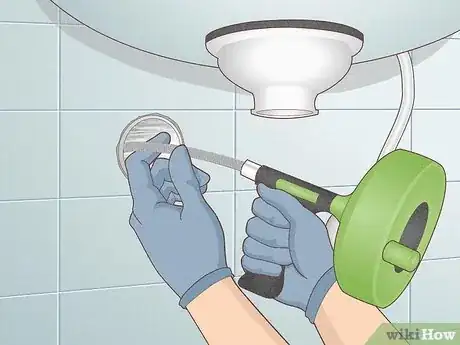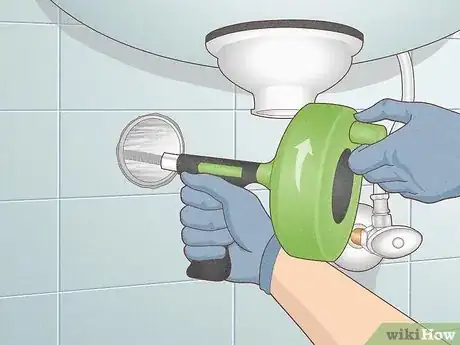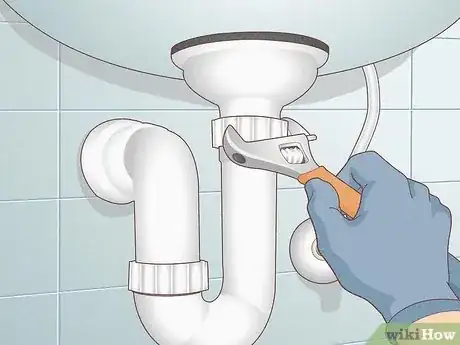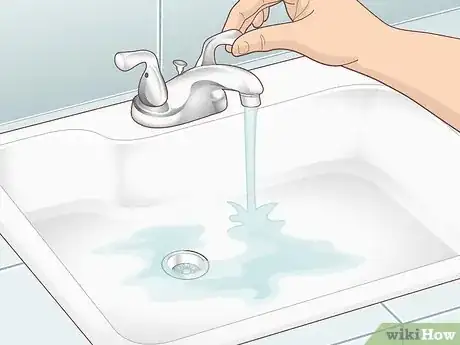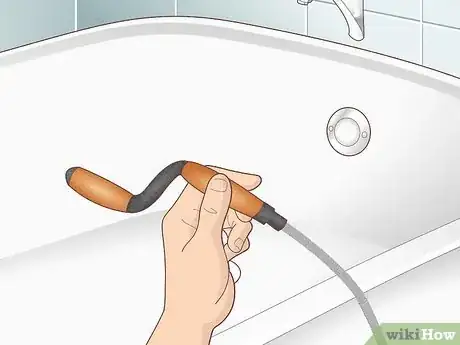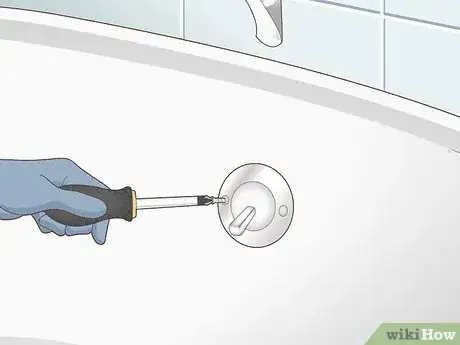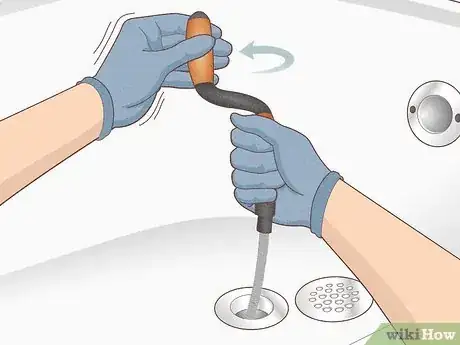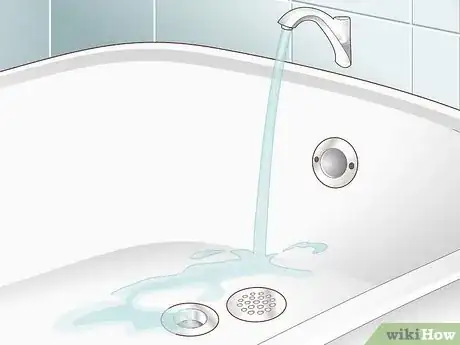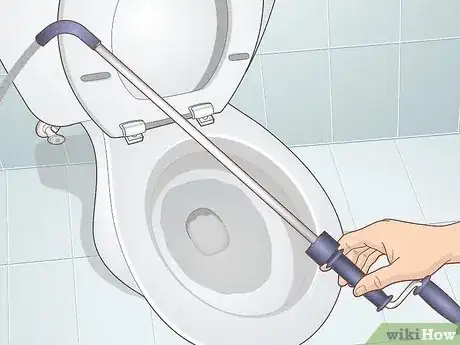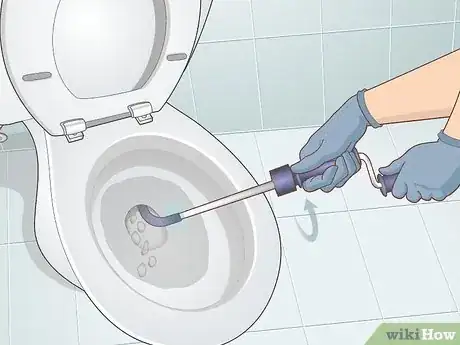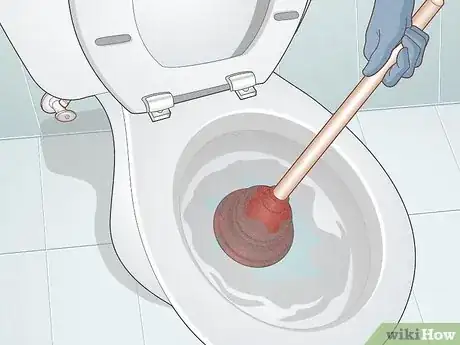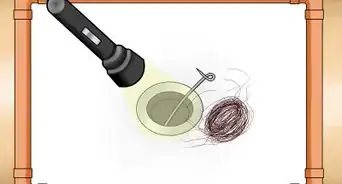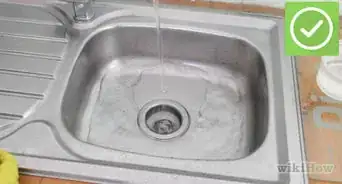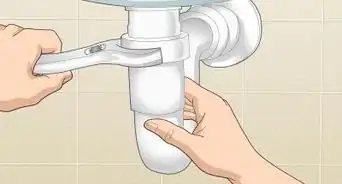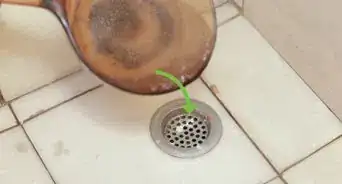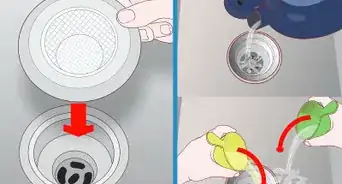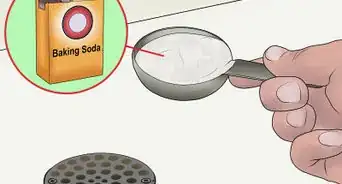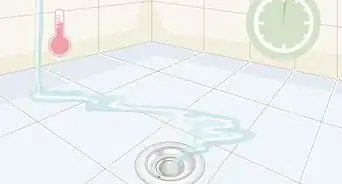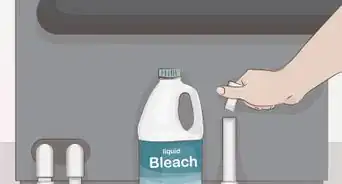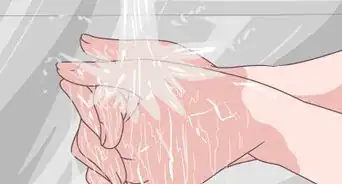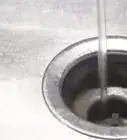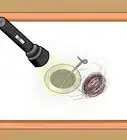This article was co-authored by David Balkan and by wikiHow staff writer, Hannah Madden. David Balkan is a Professional Plumber, CEO of Balkan Sewer and Water Main Service, and President of Balkan Sewer and Drain Cleaning. As a hands-on owner of these companies for over 40 years, David is knowledgeable about water service lines, sewers, and drain line issues. David is a Committee Chairman of the Master Plumbers Council and has sat on the Executive Committee of the Sub Surface Plumbers Association of New York for over 30 years. His knowledge and solution-oriented approach contributed to Balkan Sewer and Water Main Service being the largest and most trusted service in New York City and the recipient of the 2017 Angie’s List Super Service Award.
There are 13 references cited in this article, which can be found at the bottom of the page.
This article has been viewed 398,053 times.
Whether it’s your sink, tub, toilet, or shower, when your drain is clogged, your number one priority is getting that water moving again. Fortunately for you, using a plumbing snake is an easy way to deal with clogs at home, even if you have no professional plumbing experience. In this article, we’ll walk you through unclogging any kind of drain you might have to get your water flowing without a costly visit from a plumber. If you’re ready to use a little elbow grease and remove clogs fast, keep reading.
Things You Should Know
- To snake a sink, remove the P-trap and insert the snake into the drain in the wall. Rotate the snake to hook the clog, then slowly pull the snake out.
- To unclog a shower or tub, insert the snake into the overflow valve or the drain itself. Rotate the snake back and forth to break up the clog, then flush it with water.
- For a clogged toilet, insert the snake into the bowl and rotate the handle to break up the clog. Flush the toilet, and use a plunger if it’s still clogged.
- To snake a floor drain, insert the snake into the drain and rotate it back and forth to hook the clog. Pull the snake out slowly to remove the clog in the drain.
Steps
Sink Drain
-
1Choose a small auger that is made to snake sink drains. Small sink augers are hand-held tools that have a handle and a round compartment that houses a spool of wire with a corkscrew-like tip.[1]
- There are several types of augers that are commonly available. Choose one that has the round compartment on it, as these contain enough wire to get down into your drain. There are augers with shorter wires, which are called closet augers, but these are made exclusively for snaking toilets.
-
2Put on gloves and safety goggles. Gloves will keep your hands clean, and safety goggles will protect your eyes in case of any splashback. Safety goggles and gloves are especially important if you’ve used drain cleaner before snaking the drain. Drain cleaner can sometimes splash back out of the drain and onto your skin, which can cause irritation.[2]
- In general, it’s a good idea not to pour drain cleaner down your drain before you snake it. Save drain cleaner for after the fact so you don’t have to worry about any dangerous splashback.
Advertisement -
3Remove the P-trap to access the drain pipe. Use a wrench or screwdriver to loosen the slip nuts on both sides of the P-trap. Once they are loose, pull off the P-trap piece with just a bit of wiggling and force.[3]
- The P-trap is the curved piece of pipe directly under the drain on your sink. Its purpose is to keep sewer smells out of your house and to catch debris that might get lodged further along in your pipes.
- Place a bucket under the sink to catch water and other debris that will pour out when you detach the trap.
- Some P-traps require a screwdriver to remove, and some require a wrench. You’ll know which tool you need by looking at the attachments on the P-trap under the sink.
-
4Push the auger cable into the pipe coming out of the wall. Use your hand to push it in slowly, and keep pushing until you feel strong resistance. When you do feel resistance, pull the wire back just slightly and then try pushing it in again. If you are hitting a turn in the pipe instead of a clog, you may be able to get past it by pushing it through again.[4]
- In general, a bend in the pipe will give your wire a complete and solid stop. On the other hand, hitting a clog will feel a bit spongy.
-
5Turn the handle on the snake to break up and grab the clog. Once you have hit a stopping point, it's time for the corkscrew at the end of the wire to do its job. Turn the handle on the auger to rotate the wire inside the pipe and dislodge some of the clog.[5] Turning the handle might also cause the wire to hook onto the clog, which is just as good.
- Turn the handle slowly. You don't need to move the snake quickly.
- Keep pressure on the snake as you turn it. Pressure on the wire will help push the corkscrew end into the clog.
-
6Pull the snake out of the drain slowly. If you have successfully hooked the clog onto the end of the wire, keep it hooked so that it can be removed.[6] Be slow and gentle as you remove the wire from the pipe to avoid losing the clog.
- If you can feel a slight resistance on the wire as you pull it out, that’s probably the clog hooked onto the end.
- If the end of the snake has a clog attached to it, move on to putting the drain back together. If it doesn't, push the snake back down the pipe and try to hook it once again.
-
7Put the P-trap back together. Once you suspect that you have removed the clog, put the P-trap back in place. Put it in its original position and retighten the nuts so your sink doesn’t leak.[7]
- Keep the bucket under this area of the drain pipe. If there are any leaks while you are testing the drain, the bucket will catch them.
- Clean out any debris in the P-trap before replacing it.
-
8Test the drain by running water down it. Run a steady stream of water down the drain to determine if you have unclogged the sink. If the water starts to back up, turn off the water before it fills your sink.[8]
- It may take a few seconds to clear out debris in the pipe once you start running water. However, the water should begin to run freely pretty quickly if you have dislodged the clog.
- If you still have a clogged or slow drain, try snaking the drain 1 to 2 more times. You can also unclog a sink by using a plunger. If the drain is still clogged after your third try, it’s time to call in a professional.
- Once you’re done with the snake, slowly pull it out of the drain and rinse it off with hot water.
Tub or Shower Drain
-
1Choose a small auger made to snake tub and shower drains. Most tub and shower pipes are small and easiest to unclog with a small, hand-held auger. These augers are easy to handle and flexible, which makes them great for pushing through narrow and angled pipes.[9]
- There are 2 types of small plumbing snakes: drain augers, which are common small augers that have a round compartment with a long coil of wire in it, and closet augers, which are shorter and mostly used by plumbers to unclog toilets. A closet auger does not have the round compartment on it and so the wire length is much shorter. Choose a drain auger when getting a clog out of your tub or shower drain.
-
2Remove the faceplate from the overflow valve. In most bathtubs, there is an overflow valve directly underneath the faucet. Use a screwdriver to remove the faceplate, and set it aside for later.[10]
- Wear work gloves before starting to make gripping the snake easier.
- Going through the overflow valve is better than the drain itself, because your snake has a much straighter shot down the pipe.
- If you are snaking a shower that doesn’t have an overflow valve, just remove any drain stoppers or screens from the drain itself and snake it that way instead. Use a screwdriver to unscrew the screen, then pry it up and off the drain.
- If you used drain cleaner already, wear gloves and safety goggles. Drain cleaner can sometimes splash back out of the drain, causing irritation to your skin or eyes.
-
3Insert the auger wire into the drain. When inserting a snake, push the snake wire into the drain while simultaneously turning the handle on the back of the tool. This will turn the wire as you push, allowing it to move further down the drain through any clogs.[11]
- Some snakes only turn when the wire is in a locked position and can't be advanced. If this is the case with your snake, push the wire in a few inches and then lock the tool and rotate the wire. Repeat this by unlocking the wire, pushing it in a few more inches and then relocking and turning it.
- As you lower the cable, move your grip down until it's about 3 inches (7.6 cm) from the drain opening. This close grip allows you to control your motions and feel for the clog easier.
-
4Turn the handle on the snake to break up the clog. When you feel resistance on the snake, that’s when you know you’ve hit the clog. Turn the handle slowly to hook the clog with the snake. Use slow and steady pressure to avoid slipping the snake out of the drain.[12]
-
5Pull the snake out of the drain slowly. As you pull the cable out, turn the handle on the snake so that the cable rotates. This will help the cable move around bends in the pipe.[13]
- Pulling the cable out of the pipe slowly will help to keep the clog hooked to the end.
-
6Pour water down the drain to see if it’s still clogged. Turn the faucet on and let the water run. It might take a couple of seconds to wash away what’s left of the clog, but the water should begin to go down the drain quickly.[14]
- If the drain is still obstructed, snake the drain one more time. Insert the wire into the pipe once again and spend more time trying to hook the clog to remove it. Once you’ve gotten the clog out, reattach the faceplate or the drain cover in your tub.
- If water still won't run through the drain after you've snaked it several times, it may have been pushed further down into your pipes. In this case, it's time to call the plumber.
- Clean your snake by rinsing it in hot water, then store it in a cool, dry place.
Toilet
-
1Choose an auger that's made to snake toilets. The snake may be called a toilet snake or a closet auger.[15] These long snakes are made to fit directly into your toilet bowl.
- The auger will have a long cable and case with a handle that moves the cable in and out. The cable will have a hook on the end to grab clogs.
-
2Push the auger cable into the hole at the bottom of the toilet bowl. Put on work gloves to protect your hands. Situate the snake over the bowl, then rotate the handle on the snake as you push the cable into the drain. There will be areas that are difficult to push through, but at some point, you will likely feel strong resistance from the obstruction in your pipe. Stop pushing the wire in when it hits the clog.[16]
- It might seem as if the cable has hit a wall when you hit a curve in the pipe. Keep pushing to see if it will go past the curve.
-
3Rotate the handle on the auger to break up the clog. The hook on the end of the auger cable is designed to grab items clogging the toilet. Turn the handle on the auger to rotate the hook and grab onto the clog.[17]
- There is no need to rotate the handle quickly. Simply keep pressure on the cable as you turn the handle slowly.
-
4Pull out the cable and use a plunger to get the clog moving. Retract the auger cable slowly so that anything hooked on the end of it will be pulled out of the drain. Then, plunge the toilet and watch for water to flow down the drain.[18]
- To plunge the toilet, place the plunger over the drain. Make sure the rubber head is flush against the toilet around the drain so that it creates a seal. Then, push the plunger so the rubber head inverts. Let it pop back up and push down again. Do this several times until water starts draining through the drain.
- Many drain clogs can be removed using a plunger. If you haven't already given it a whirl, it's worth trying so you can avoid the more time-consuming process of snaking your drain.
- If the water doesn't drain, put the plunger away and snake the drain again. If your toilet won’t flush after you snake it 2 to 3 times, call a plumber instead.
- Clean your snake off with hot water, then store it in a closet or pantry for future use.
Floor Drain
-
1Get an auger designed for snaking floor drains. This is typically a small, manual hand-held auger that is called a “drain auger” on its packaging. It’s also what you would use to snake a sink or shower drain.[19]
- Plumbers often use electric augers, but those are typically not worth the financial investment for fixing your own drain clogs that only happen once in a while.
-
2Remove all covers and backflow valves from the drain. In most cases, you will have a cover on the drain that can be removed simply by unscrewing it. Once you unscrew it, look down into the drain. If you see an item that looks like a ball locked under a ring, remove this, too. Push a flat-head screwdriver between the edge of the pipe and the ring and pry it out of the drain.[20]
- Set the ring, ball, and cover aside in a safe spot so you can put them back in place after the clog is eliminated.
- When working on the floor drain, it’s a good idea to wear rubber gloves. This will keep all dirt and debris in the drain off of your hands.
-
3Start pushing the cable down into the drain. Feed the cable out of the tool and into the drain until you hit the clog. To feed the cable, you may need to release a handle on the tool, but each auger will be slightly different. Keep pushing the cable down into the drain even when you feel a bit of resistance, as this may simply be a bend in the pipe. When you have tried to push past an area of resistance several times to no avail, you have likely hit the clog.[21]
- In some cases, you can tell that you are at a clog because the cable won’t advance any further, but it gives a little every time you push on it. If it’s stuck at a bend in the pipe, it won’t budge at all, even with pressure.
-
4Hook the clog by rotating the cable in the pipe. Turn the cable by rotating the handle on the auger. Once you’ve rotated the cable several times, pull up slightly on it to see if you've captured any of the clogged matter. Push and prod the clog to begin breaking it up while trying to hook it.[22]
- Work on the clog until you can feel that you’ve punctured through the other end. Continue turning the handle to break up the clog into smaller pieces.
- If the clog won't seem to budge, it may be a solid object that you've hooked.
-
5Pull the clog out slowly. Pull the snake out of the drain with care by winding it back into the container. Be gentle so you don't lose the clog if it's hooked on the end of the snake.[23]
- Clean the mess off the snake with a towel as it emerges. Dump the drain matter into a bucket, then replace the parts of the drain that you removed.
- Keep pulling up as much of the clog as you can until the snake is free. If the drain is still clogged, snake it again 1 to 2 more times.
- If your drain is still clogged after snaking it 3 times, call a professional plumber.
- Rinse your snake off with hot water before storing it.
Community Q&A
-
QuestionHow do I see where in the drain pipe the snake is going?
 Community AnswerThere is no way to see it unless the drains are above the tube and transparent. You just have to twist the snake around until things get moving. You could also try Drano or something like that if you want to save your energy.
Community AnswerThere is no way to see it unless the drains are above the tube and transparent. You just have to twist the snake around until things get moving. You could also try Drano or something like that if you want to save your energy. -
QuestionHow much does a closet auger or a snake cost?
 Community AnswerIn the U.S. expect to pay about $1/ft for a manual (nonelectric) snake auger.
Community AnswerIn the U.S. expect to pay about $1/ft for a manual (nonelectric) snake auger. -
QuestionThe drain hook is hooked on the inside of the garbage disposal drain. How can I release it?
 SGrosjeanCommunity AnswerThe first thing you can do is move the propeller of the garbage disposal. You should have a key that you insert into the bottom of the disposal which you turn to manually turn the propeller. If this doesn't release your tool, you will likely need to take apart the garbage disposal or call a plumber.
SGrosjeanCommunity AnswerThe first thing you can do is move the propeller of the garbage disposal. You should have a key that you insert into the bottom of the disposal which you turn to manually turn the propeller. If this doesn't release your tool, you will likely need to take apart the garbage disposal or call a plumber.
Warnings
- Don't dump solid objects down the drain. Throw all solid objects in the trash instead, even if they're seemingly too small to cause clogs.⧼thumbs_response⧽
Things You'll Need
Snaking a Sink Drain
- Drain auger
- Bucket
- Safety goggles
- Gloves
- Screwdriver
- Wrench
Snaking a Tub or Shower Drain
- Drain auger
- Old towels
- Bucket
- Rubber cleaning gloves
- Screwdriver
- Wrench
Snaking a Toilet
- Closet auger
- Plunger, if necessary
- Rubber cleaning gloves
Snaking a Floor Drain
- Drain auger
- Old towels
- Rubber cleaning gloves
- Screwdriver
- Wrench or pliers
References
- ↑ https://www.thisoldhouse.com/plumbing/21164644/how-to-clear-any-clogged-drain
- ↑ https://sds.chemtel.net/docs/KIK%20International%20Inc-0002907/KIK%20International%20LLC_Great%20Value%20Drain%20Cleaner%20Maximum%20Strength%20(GHS)_78742-06883-22573068082_05-06-2015_English.pdf
- ↑ https://www.thisoldhouse.com/how-to/clear-any-clogged-drain
- ↑ https://www.youtube.com/watch?v=hySkwXMn0pA&t=377s
- ↑ David Balkan. Professional Plumber & CEO of Balkan Sewer & Water Main. Expert Interview. 29 April 2021.
- ↑ David Balkan. Professional Plumber & CEO of Balkan Sewer & Water Main. Expert Interview. 29 April 2021.
- ↑ https://www.thisoldhouse.com/plumbing/21164644/how-to-clear-any-clogged-drain
- ↑ https://www.thisoldhouse.com/how-to/clear-any-clogged-drain
- ↑ https://www.youtube.com/watch?v=2u1t3s_XpXk&t=46s
- ↑ https://www.youtube.com/watch?v=xV5fuMRe4nM&t=103s
- ↑ https://www.thisoldhouse.com/how-to/clear-any-clogged-drain
- ↑ https://www.thisoldhouse.com/how-to/clear-any-clogged-drain
- ↑ https://www.youtube.com/watch?v=2u1t3s_XpXk&t=316s
- ↑ https://www.thisoldhouse.com/how-to/clear-any-clogged-drain
- ↑ https://www.thisoldhouse.com/plumbing/21164644/how-to-clear-any-clogged-drain
- ↑ https://www.thisoldhouse.com/how-to/clear-any-clogged-drain
- ↑ https://www.youtube.com/watch?v=cbVuF98g-dE&t=131s
- ↑ https://www.thisoldhouse.com/plumbing/21164644/how-to-clear-any-clogged-drain
- ↑ https://www.youtube.com/watch?v=lCHcmEwNwic&t=32s
- ↑ https://www.thisoldhouse.com/plumbing/21164644/how-to-clear-any-clogged-drain
- ↑ https://www.youtube.com/watch?v=lCHcmEwNwic&t=108s
- ↑ https://www.youtube.com/watch?v=lCHcmEwNwic&t=155s
- ↑ https://www.youtube.com/watch?v=lCHcmEwNwic&t=299s
About This Article
To snake a sink, tub, or shower drain, put on a pair of rubber gloves and remove anything that is obstructing the drain, like a drain stopper or hair trap. Next, insert the auger wire into the drain and twist it while pushing it into the drain until you feel resistance. Then, when you hit the clog, keep turning the snake while pushing and prodding the clog until you break it up. Finally, slowly pull the snake out and flush the drain with water to confirm the clog is gone. For tips on what to do if the drain is still clogged after the first snaking, read on!



